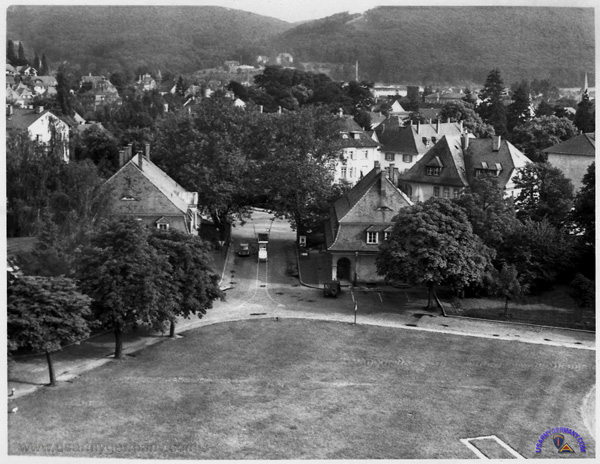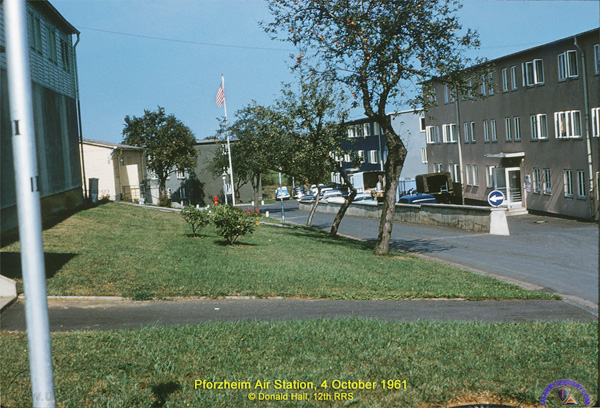Click here to open 'USArmyGermany' frameset
FIAT BUILDING |
KARLSRUHE MISC. |
|
|
| 1950 Map of Sub-Post facilities in downtown Karlsruhe. This map was included in a handbook for newcomers to Heidelberg Military Post, issued in 1950. Click on the thumbnail to view a larger format of the same map. |
 |
| 1980 Topographical maps of Karlsruhe and surrounding area. These maps are reproduced from the "U.S. Military Installation Atlas" published by the 37th Transportation Group in 1980. Click on the thumbnail to view a larger format of the same map. Click here for a list of the installations. |
 |
 11. MP Station |
 12. MP Station |
||
 Headquarters Area Command Motor Pool, Smiley Barracks, 1954 (Donald Gilbert) |
 13. Motor pool |
 14. Snack Bar |
 15. Smiley sign main gate |
|
 16. 15th Med Det |
|||
 17. Barracks building |
 18. Sub post motor pool |
 19. Warehouses |
||
|
|
|||||
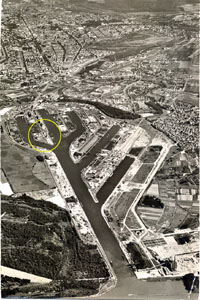 1. Rheinhafen |
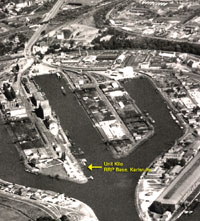 2. Unit K, RRP |
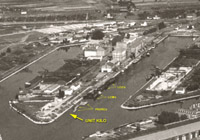 3. Unit K, RRP |
|||
|
|||||
 1. UP building |
 2. Kaserne |
 3. Motor pool |
 4. Main street |
||
 5. Typical barracks building at Neureut |
|||||
| Ettlingen | |||||
 A. Rheinland Ksn |
 B. Rheinland Ksn |
||||
|
 Rheinland Kaserne main gate, Ettlingen (Jess Ray Keopke) |
 1. Rheinland Ksn, 1967 |
 2. HHC, 78th Engr Bn Bldg |
 3. Movie Theater |
|
 4. Area behind Bldg 9723 |
 5. Motor pool |
||
| Germersheim |
 Germersheim Army Depot, recent (Mike Smith) |
 Germersheim Army Depot, recent (Mike Smith) |
 1. Aerial of Army Depot, 1962 |
|||
| Knielingen | |||
 A. Rhein Ksn |
|||
 1. Main Gate sign (KB) |
 2. 761st Med Det sign (KB) |
|||
|
 1. Entrance |
 2. Mess Hall |
 3. Bldg 113 |
 4. Bldgs 103 & 121 |
 5. Access road to Air Station |
 6. Gate |
||
 7. (KB) |
 8. (KB) |
 9. (KB) |
 10. (KB) |

FIAT Building on 4 Kaiser-Allee, Karlsruhe, 1945 (Webmaster's collection)
(This building would serve as the home of HQ Karlsruhe Sub-post during the
late 1940s and early 1950s)
|
HISTORY OF KASERNES (1958) |
Little post with big mission Germer who? You might ask! Or is it, Germer's what? If you're like me, before I was assigned to find out, you probably know the Army does something in Germersheim but not what. I didn't even know where Germersheim is! I was surprised to discover that not only is Germersheim one of the most important Army posts in Europe, it also has what may be the longest and richest history of any post in the U.S. Army - dating back to before the time of Christ. Justly proud of it's role at Germersheim is the KarIsruhe DEH which has responsibility for making sure facilities at Germersheim run well so the people there can perform their mission effectively. Germersheim is really a quiet, almost sleepy little town on the west bank of the Rhein, 13 crow-miles north of Paul Revere Village. Interesting shops and stores line a puzzle-like network of streets that wind around massive buildings, once part of a great fortress. People are friendly to Americans, perhaps because the military has always been a part of the city's history. In addition to the American post, Germersheim is also home for three German Wehrmacht caserns (should be: Bundeswehr) and a Luftwaffe casern. When Americans talk about Germersheim, they usually mean the Germersheim Military Sub-community located on the west edge of town. About 2000 Americans live here -- 600 military members and families -- and nearly 1700 local nationals working for the several organizations that conduct the Army's business. The sub-community includes 5.2 square kilometers of land area, miles of roads, a major train depot, the only fire department in the Karlsruhe Military Community and 160 structures including everything from schools to a movie theater plus several warehouses, each of which is large enough for three football games to be played simultaneously. The post is not one of those typical German caserns with well-laid out cobbled streets lined with trees. It looks more like a gigantic parking lot for imported cars that you'd find in New Jersey or California. A closer look reveals row after row of tanks, trucks, personnel carriers, bridge sections -- more vehicles and materiel than the entire armies of many countries. This mind-boggling stockpile belongs to the General Support Center Germersheim, just one of the "Big Three" tenants at the post. Formerly called the Germersheim Army Depot, GSCG is one of four war reserve depots in Europe, the others being in England, Luxembourg and Kaiserslautern. GSC 's main mission is to store and maintain all the equipment necessary to replenish whatever might be knocked out of action during a real war. Just maintaining the $1.4 billion worth of equipment is a big peacetime job. Every vehicle must be "exercised" periodically -- fueled, engine run, put through gear changes to make sure all seals are lubricated and so forth. Every vehicle must be ready to move out on short notice. Another, not so visible Germersheim tenant, is the 4th Combat Equipment Company. Their mission is to store, maintain and issue vehicles and equipment in case of war and, in peactime, to troops arriving from the States during Return of Forces to Germany exercises. Their materiel, called POMCUS for "Preposition of Materiel Configured in Units Sets," isn't so visible because it is stored in massive, dehumidified NATO warehouses. Whereas the GSCG equipment must be able to move out with only a few hours notice, the POMCUS equipment must be ready to go instantly, at all times. Last of the "Big Three" tenants at Germersheim, and most important if you believe Napoleon who said, "An army marches on its belly," is the Defense Logistics Agency -- the commissary people. Germersheim is the commissary's non-perishable food storage and transhipment facility for Europe. If food supply lines from the States were interrupted for some reason, Germersheim could keep us marching for a good while. And, since even "non-perishable" food has a limited shelf life, the commissary people are constantly rotating stock -- shipping cigarettes, coffee, canned goods, etc. all over Europe and replenishing the stock with new supplies from the States. In addition to the "Big Three," Germersheim is also home for the 137th Ordnance Company, which provides ammunition to prestock points in the Karlsruhe community, and Company B, 63rd Signal Company, which provides communications support to USAREUR headquarters. "Germersheim is really a factory," says Lt. Col. John K. Joseph, the two-hatted commander of both the sub-community and GSCG. "It's like a major industrial complex with a lot of different functions and we count on DEH to keep us in business." The DEH boss at Germersheim is Engineering Support Division Chief Rolf Raab. "Raab does a super job, says Joseph. "He's our roads and grounds, boiler plants, utility support for the shops, emergency repair service; he even does minor construction and provides support to our marshalling areas -- support damage, etc." Joseph says that since arriving from Washington, D.C. in July 1983, he's seen a lot of renovation projects completed including the troop billets, dining facility, theater, post exchange and bowling alley. "If the weather warms up, we'll also be breaking ground shortly for a new school building." Division Chief Raab says there's a lot more on the drawing board. New projects already approved include construction of a small arms repair shop, a vehicle maintenance shop and a child development center. Other upcoming projects include road widening, fence repair, a new parking lot for the commissary warehouses and several renovation projects. "In all, about 35 projects are planned," says Raab, "and if everything is approved and funded, we will have rehabilitated 60 percent of all the buildings in the sub-community." Joseph also has high praise for Rudy Nothdurft, DEH's chief housing watchdog for Germersheim. "We lease six high-rise apartment buildings," says Joseph, "but of course we can't spend any military money on improvements. Rudy has been very successful in getting the landlords to provide playgrounds and equipment for the kids. All of this helps to make the sub-community more livable for the residents." How do Americans like living in Germersheim? Joseph says he can't speak for everyone but for him, "Germersheim is a paradise compared to living in Washington, D.C. " |
By Debbi Merrill
Editor
"You shouldn't have to think about how the products get to the commissary or the mess hall; it should just happen," claims Maj. Kevin Scott, chief of the Defense Subsistance Storage Facility at Germersheim, where semi-perishable products are stored. Behind two guarded gates at the Germersheim sub-community, on the far side of fields filled with tanks, trucks and assorted stored vehicles, sit three mammoth warehouses. Inside each warehouse is row upon row, pallet upon pallet of 2,000 assorted food and associated products for resale to commissaries and for use by soldiers. Scott's job is to supervise about 200 local national employees in the running of the massive operation that keeps soldiers and their families eating in Germany and other locations. Only one other American is assigned to the facility and he is NCOIC, SFC Lorenzo Cruz. "We're the wholesaler that ships to the commissaries," Scott said. |
 |
|
When a release arrives from the inventory control center, the goods are again on their way, closer to their final destination. "If goods don't sell by 35 days prior to the expiration date of shelf life, we have to do something - usually change the prices to sell quickly," Scott said. "Some commissaries will order items to sell at a discount." Members of the 7th Medical Command Veterinary Services inspect products at the Germersheim facilities. Other veterinarians inspect food products in individual commissaries. "They open packages and look at the items and after the expiration date they test to make sure the product is still wholesome," Scott said. "They also determine how long the item will have shelf life." He said the government buys food with a warranty that the food is in good condition when it is purchased. "Food damaged in shipment is not refundable if it's not the fault of the manufacturer," Scott said. Although all of the items stored in the warehouses may be easy to resell if they were to fall to dishonest people, the highly pilferable ones which include cigarettes and coffee, are kept in a security warehouse. Scott said there haven't been any thefts from the warehouses in years. When a shipment is being readied to leave the warehouse and the items have been selected and stacked to go, cases of products are positioned under a machine that takes a giant plastic bag and shrinkwraps it around each case. "We shrink-wrap everything because the plastic is stronger than straps; it melts on the (packaged) merchandise," Scott said. "In the States, the cartons go through a big oven on a conveyor belt, but our smaller machine works just as well." What happens when a commissary is too busy to accept their order? "If a commissary is swamped, for whatever reason, and can't unload products, they are held here until the commissary can take it," Scott said. "This saves the government detention charges. If we have usable floor space and there is a commissary in a bind, we'll hold the order." In addition to the commissary and dining facility storage work, the warehouse is also the location of operational rations which are dehydrated food and T Rations for the troops. During recent REFORGER operations, Scott said there were long lines of trailer trucks waiting to be loaded with goods for the field. "We also send all Department of Defense equipment from here," the chief said. "There are 171 different schools that we ship to." Although the Defense Subsistence Storage Facility in Germersheim is in a part of the Karlsruhe Military Community, only a dozen of the products stored there make their way to the Karlsruhe community commissary. Karlsruhe's commissary items are channeled through facilities in Mannheim. "In an emergency, the Karlsruhe commissary manager could get items from Germersheim offline products," Scott said. Another mission is one that hopefully will never be tested. "The rations for different forces are stored here," Scott said. "The quantity of dehydrated items the Army has purchased is based on a pre-determined plan. During wartime, we would not be running commissaries." |
 |
|
 |
An overview of the history of Wartberg Kaserne. Click on the chart to view a larger resolution image. Anybody who has additional details about Wartberg Kaserne in Pforzheim or knows about units that served there is kindly requested to contact the webmaster. |
 VKK 523 FOB
VKK 523 FOB The Verteidigungskreiskommando (VKK) was an element of the German Territorial Army (Territorialheer), the part-time reserve component of the German Army. The Territorialheer was organized, trained and equipped to reinforce the Bundesheer (Active Army) on short notice. Most Territorialheer soldiers lived close to their mobilization stations, and most units were earmarked for operations in their home regions -- thus the name 'Territorial Army'. The VKK 523 home station was Pforzheim. Higher headquarters for VKK 523 was the VBK 52 (Verteidigungsbezirkskommando) in Karlsruhe. |
Related Links: Rhine River Patrol, Karlsruhe (Unit K) - a great photo page (photos provided by Ralph Rice) on Andrews Baggs' web site dedicated to the US Navy's Weser and Rhine River Patrols 79th Engineer Combat Battalion (Heavy) - Joe Nisil's page on the 79th Engr Bn and Gerszewski Barracks, Knielingen (Karlsruhe), 1979-81 Rhein Kaserne Gerzsewski Barracks |


























